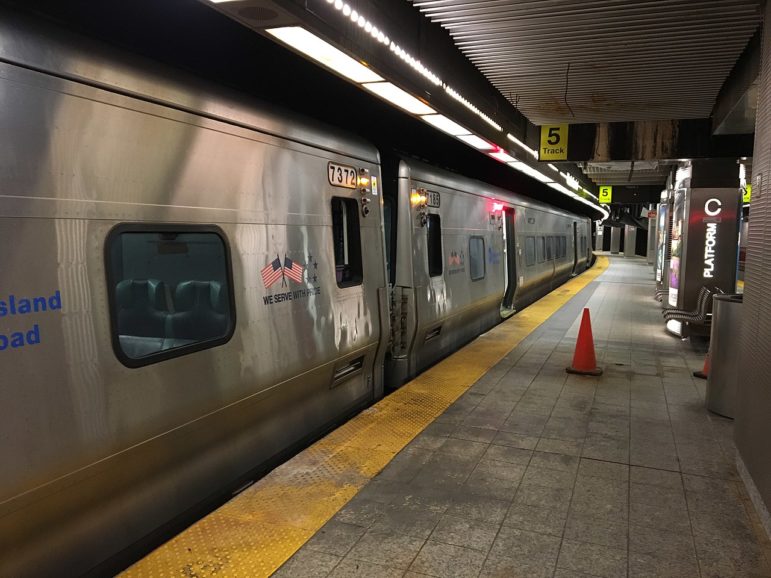
Spike9936
One aim of an MTA discount ticket program is to shift more riders to changing from LIRR to the subway at Atlantic Terminal, pictured above, rather than at more crowded Penn Station.
The MTA is extending a pilot program that offers cheaper LIRR tickets to Atlantic Terminal for riders in Brooklyn and some Queens neighborhoods—and transit advocates hope to see the model expanded to other outer borough areas, including those served by Metro-North.
The program, dubbed the Atlantic Ticket, will be renewed for another year, LIRR President Phillip Eng announced Monday. It lets riders travel between Brooklyn and seven LIRR stations in Queens into Atlantic Terminal for a discounted $5 one-way fare, instead of the normal cost of $10.25 at peak times. A weekly unlimited-ride ticket costs $60 under the Atlantic pilot and includes a transfer to NYC Transit subways and buses, what would normally run riders in southeast Queens $104.25, according to the MTA.
“It’s a common goal of providing more mass transit opportunities to our public, and we’re seeing positive results,” Eng said Monday during a meeting of the MTA Board’s LIRR committee.
During the first year, customers purchased 875,000 Atlantic Tickets, or 1.3 million trips, averaging 31,000 rides a week, according to MTA Spokesman Aaron Donovan. The program costs the MTA a net $1 million to $2 million annually, the agency said. A survey of Atlantic Ticket customers found that 11 percent used to travel into Penn Station but switched their destination to Atlantic Terminal thanks to the pilot, while another 30 percent of customers said they previously travelled by bus or subway.
These changing travel patterns are “helping to balance riders out across the western terminals,” Eng said. He did note, however, that “a few morning peak trains” are above capacity between Jamaica and Atlantic terminal—the most popular trip under the pilot—something the LIRR is “carefully monitoring.” Another hiccup has been users purchasing the Atlantic Ticket for rides into Penn Station, which aren’t eligible for the discount, Eng said.
Transit advocates cheered the MTA’s decision to renew the pilot, and say they hope the Atlantic Ticket model can be adapted to other neighborhoods served by the MTA’s commuter rail lines, including the Metro-North’s stations in The Bronx. The LIRR and Metro-North offer quicker commutes for many outer borough riders compared to the subway or bus, but are significantly more expensive.
Get the best of City Limits news in your inbox.
Select any of our free weekly newsletters and stay informed on the latest policy-focused, independent news.
“We have this great rail infrastructure running through the boroughs, but sometimes folks can’t afford it,” says Andrew Albert, an MTA board member and chair of the Permanent Citizens Advisory Committee to the MTA (PCAC). The group has been advocating for years for reduced commuter rail fares in the outer boroughs—the Atlantic Ticket is based on their own “Freedom Ticket” proposal, which would apply citywide—on the grounds that doing so could drastically cut commute times for many riders, and help relieve crowding on overburdened subway and bus routes.
“We would like to see it implemented on a larger scale,” says PCAC Executive Director Lisa Daglian, who said they would ultimately like to see Penn Station included for the discount. “We’d need to see what the capacity issues are.”
Travel between the MTA’s different operating agencies will also be easier in the future, she notes, as the agency moves forward with its adoption of OMNY, a new digital fare payment system, paving the way for more seamless transfers between the LIRR, NYC Transit and Metro-North.
“Encouraging people to get out of their cars, off express buses, and to take the most convenient rail option—whether it’s subway, whether it’s commuter rail,” Daglian says, “[gives] people the one thing they can’t buy, and that’s time.”










7 thoughts on “MTA to Keep Offering Discounted LIRR Rides to Atlantic Terminal”
Why didn’t the one year extension of the Long Island Rail Road’s “Atlantic Ticket” discount program as a response to the NYC Council’s “Commuter Rail Fare Equalization Proposal” for southeast Queens residents not include Rockaway residents who can access the Far Rockaway LIRR Station? This plan to start in several months will provide a discounted rush hour ticket of $5.00 versus $10.25 peak and $7.25 off peak. There is also a weekly seven day combined LIRR and NYC Transit subway pass for $60 versus $104.25. These reduced fares will be available for those who travel from Atlantic Avenue Brooklyn LIRR Terminal to stations in Queens Village, Hollis, St. Albans, Rosedale, Laurelton, Locust Manor, Jamaica, East New York and Nostrand Avenue but not Far Rockaway.
The idea is to offer residents of under served transportation neighborhoods inexpensive faster transportation options using underutilized LIRR trains.
Those NYC residents who already utilize either the LIRR, Metro North, MTA Bus or NYC Transit Express Bus are aware the cost is more than either the bus or subway. If you agree and follow the logic of this bill, there should be a reduction in the cost of any NYC Transit or MTA Express Bus Service from $6.50 to $2.75 as well. There are already almost 100,000 NYC residents who travel weekday to and from work paying extra to ride the LIRR, Metro North, MTA Express Bus, NYC Transit Express Bus or private ferry. All understand that they are paying for a premium service.
Why shouldn’t Rockaway residents be able to join other Queens neighbors from Rosedale, Laurelton, Locust Manor, St. Albans, Bellrose, Queens Village, Hollis and Jamaica in being able to access the same discounts via the Far Rockaway LIRR Station for both $4.00 weekend City Zone and now new weekday ticket discounts? From the Far Rockaway LIRR Station in less than one hour, you can arrive at either Penn Station or Atlantic Terminal. Within 35 minutes, you can be at Jamaica LIRR Station.
Who among Congressmember Gregory Meeks, Borough President Melinda Katz, State Senators Joseph Adabbo and James Sanders, Jr., State Assemblymember Stacey Pheffer Amato, NYC Councilmembers I Daneek Miller and Eric Ulrich will be the first to address and resolve this injustice on behalf of Rockaway taxpayers and constituents on this issue? Your response should be of interest to Rockaway commuters especially come Election Day
(Larry Penner is a transportation historian, writer and advocate who previously worked 31 years for the Federal Transit Administration Region 2 New York Office. This included the development, review, approval and oversight for billions in capital projects and programs for the MTA, NYC Transit, Long Island Rail Road, Metro North Rail Road MTA Bus, NYC Department of Transportion, New Jersey Transit with 30 other transit agencies in NY & NJ)
.
This would be a good time for the MTA – Long Island Rail Road to reopen the Lower Level Woodhaven Junction Station to aide Ozone Park, Woodhaven and Richmond Hill passengers in commuting to Manhattan much faster than presently.
So Eastern queens east of queens village is screwed over?
Pingback: How New York’s Atlantic Ticket Approaches Transit Equity Differently – SmartCities.org
Pingback: NYC's Discounted Travel for Underserved Areas - WELCOME TO NEWSSPOT
What i do not realize is in fact how you’re now not actually a lot more smartly-liked than you may be right now. You’re so intelligent. You understand thus significantly relating to this subject, produced me in my view believe it from a lot of numerous angles. Its like men and women are not involved except it’s something to accomplish with Woman gaga! Your personal stuffs great. Always care for it up!|
This beautiful lirr infrastructure was beautiful and you paid for it to have a nice clean not crowded train it waslike first class onanairplane where you paid more for what you get now you have all eco omy seats trash e erywhere on these ni e trains and crowdi g an d drunks who re e tly spilled beer all over my wife comi g home fromwork thanks to barklycenter a nd the islander stadium why should i pay more than those 5 dollar tickets and get less quality on the train eachtrainshould have seating like the air planes have lets change theairlines to while your at it and on top of it the ones thatneed to get home after 12 hourshifts at work will gethome later because the nice express trainwe had has to runlocal now from atla tic to queens village geniouses